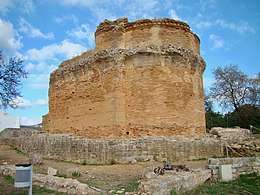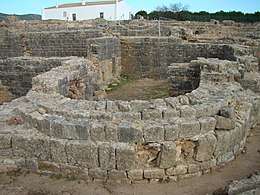Roman Ruins of Milreu
| Roman Ruins of Milreu (Ruinas Romanas de Milreu) | |
| Roman Ruins of Estói | |
| Ruins (Ruinas) | |
.jpg) A view of the ruins with the 16th century house in the background | |
| Official name: Ruínas de Estói/Ruínas de Milreu | |
| Named for: Estói | |
| Country | |
|---|---|
| Region | Algarve |
| Subregion | Algarve |
| District | Faro |
| Municipality | Faro |
| Location | Conceição e Estoi |
| - coordinates | 37°5′42.2″N 7°54′14.3″W / 37.095056°N 7.903972°WCoordinates: 37°5′42.2″N 7°54′14.3″W / 37.095056°N 7.903972°W |
| Architects | Ditza Reis, Pedro Serra Alves |
| Style | Roman |
| Material | Granite |
| Initiated | 1st Century |
| - Completed | 10th century |
| Owner | Portuguese Republic |
| For public | Public |
| Easiest access | EN2-6, between Coiro da Burra and Estoi, alongside the junction between Faro da Via do Infante, 9 kilometres (5.6 mi) from Faro |
| Management | Instituto Gestão do Patrimonio Arquitectónico e Arqueológico |
| Operator | DRCAlgarve; Dispatch 829/2009; Diário da República, Série II, 163 (24 agosto 2009) |
| Status | National Monuments Monumento Nacional |
| Listing | Decree 16 June 1910; DG, 136 (23 June 1910) |
| Wikimedia Commons: Ruínas de Estói | |
The Roman Ruins of Milreu (Portuguese: Ruinas Romanas de Milreu) is an important Roman villa rustica located in the civil parish of Estói in the municipality of Faro, in the Portuguese Algarve, classified as a Monumento Nacional (National Monument).
History
The town was constructed and inhabited since the 1st century,[1] with traces of continuous occupation until the 10th century.[2] Comparable to a large number of rustic villas of Italy, Milreu is punctuated with decordorated home, equipped with ancient imperial busts, a temple devoted to a water cult, as well as winery and oil mill.

Sometime between the 3rd and 4th century, the main signeurial homestead was remodeled, with the temple adapted for use by the Christian cult.[1][2] At the end of the 3rd century, the house was reorganized around a large central peristyle with columns, surrounding an open courtyard with garden and thermae.[1][2] In the 4th century, the entrance of the villa was monumental, and the peristyle and the baths were embellished with mosaics representing marine fauna, while to the south stood an imposing building of worship to an aquatic deity, that in the following century would be transformed into a Paleochristan temple.[1][2]
Later excavations emphasized a long tradition of worship in Milreu, demonstrating that after the 6th century, the building was transformed into a Christian church, and the courtyard was also used as a cemetery during the Muslim occupation.[2] In the first half of the 10th century, the vaults were ruined at the site, the spaces were abandoned.[2]

The construction of the rural house occurred in the 16th century.[1][2]
The ruins were discovered in 1877 by archaeologist Estácio da Veiga. The late-19th-century excavations by Estácio de Veiga made it possible to unravel mosaic works that were buried beneath the dwelling, as well as wine-processing facilities.
On 1 June 1992, the property was placed under the protection of the Instituto Português do Património Arquitetónico (Portuguese Institute for Architectural Patrimony).[1][3] The site was included in the 1999 Programa de Valorização e Divulgação Turística (Tourism Valuation and Dissemination Program), as part of the Itinerários Arqueológicos do Alentejo e Algarve project of the Ministério do Comércio e Turismo and Secretaria de Estado da Cultura.[1] On 23 June 2001, a public tender was issued for remodelling the 16th-century rural house, to construct an interpretative centre, which was won by architects Ditza Reis and Pedro Serra Alves.[1] Work on the site included civil construction and electrification, excavation, conservation and restoration of the walls. The site was re-inaugurated on 19 November 2003, with the opening of a permanent exposition.[1]
As of 20 December 2007, the property was placed under the authority of the Direção Regional da Cultura do Algarve (dispatch 1130/2007; Diário da República, Série II, 245).[1]
Architecture
The site is located in an isolated rural area, behind a bridge, west of the cemetery and roadway.[1]
The site includes a signeural house, organized around a central patio, change rooms in the east, temple in the south and agricultural installations. The central patio consists of a peristyle with 22 columns.[1] A thermal spa includes a sequence of apodyterium, frigidarium, circular bathing pool, tepidarium and caldarium decorated with mosaics (one with oblong fish designs).[1] The ruins of an aquatic sanctuary include an altar that served as paleo-Christian church, as indicated from the presence of a baptismal pool and a small mausoleum on the patio.[1]
Nearby the ruins is the 16th-century rural house, used as interpretative center, that includes cylindrical buttresses along the outer corners.[1]
Interpretative Center
Gallery
 Floor mosaic
Floor mosaic Wall mosaic
Wall mosaic.jpg) Floor mosaic depicting a squid
Floor mosaic depicting a squid Mosaics at Milreu
Mosaics at Milreu Bust of Gallienus
Bust of Gallienus Bust of a woman at the Milreu museum
Bust of a woman at the Milreu museum Hypothetical representation of the temple
Hypothetical representation of the temple
References
Notes
- 1 2 3 4 5 6 7 8 9 10 11 12 13 14 15 Neto, João; Gordalina, Rosário (2003), SIPA, ed., Ruínas de Estói / Ruínas de Milreu (IPA.00002883/PT040214040001) (in Portuguese), Lisbon, Portugal: SIPA – Sistema de Informação para o Património Arquitectónico, retrieved 22 August 2018
- 1 2 3 4 5 6 7 IGESPAR, ed. (2011). "Ruínas de Estoi" (in Portuguese). Lisbon, Portugal: IGESPAR-Instituto de Gestão do Património Arquitectónico e Arqueológico. Retrieved 22 August 2018.
- ↑ Decreto-lei 106F/92 (in Portuguese) (Série IA, 126), Diário da República, 1992
Sources
- Roteiros da Arquelogia portuguesa: Milreu - Ruinen (in German), Lisbon, Portugal: Portugiesisches Institut des archäologischen Patrimoniums, 2002
- Schattner, Thomas G. (1998), Archäologischer Wegweiser durch Portugal (in Portuguese), Mainz: Philipp von Zabern, pp. 204–207, ISBN 3-8053-2313-1
- Teichner, Felix (2008), Zwischen Land und Meer – Entre tierra y mar. Studien zur Architektur und Wirtschaftsweise ländlicher Siedlungen im Süden der römischen Provinz Lusitanien (in Portuguese), Stvdia Lvsitana 3 (MNAR) / Madrider Beitr. (DAI), ISBN 978-84-612-7893-0
- Trillmich, Walter; Nünnerich-Asmus, Annette (1993), Hispania Antiqua – Denkmäler der Römerzeit (in German), Mainz: von Zabern, ISBN 3-8053-1547-3
- Botto, C. Pereira (1898), "Iconografia parcial das construções de Milreu", O Archeologo Português (in Portuguese), p. 158
- Rosa, J. Cunha (1969), Anais do Municipio da Faro (in Portuguese) (I)
- Veiga, S.P.M. Estácio da (1880), A tábua de bronze de Aljustrel (in Portuguese), Lisbon, Portugal